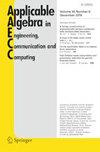关于Goppa码的维度的注意事项
IF 0.6
4区 工程技术
Q4 COMPUTER SCIENCE, INTERDISCIPLINARY APPLICATIONS
Applicable Algebra in Engineering Communication and Computing
Pub Date : 2022-09-14
DOI:10.1007/s00200-022-00578-z
引用次数: 0
摘要
让\(\Gamma (L, g)\)成为\({\mathbb {F}}_q\) 上的Goppa代码、其中 \(L\subset \mathbb {F}_{q^{m}}\) 是一个支持,而 \(g(x)\in \mathbb {F}_{q^{m}}[x]\) 是一个在 \({\mathbb {F}}_{q^{m}\) 中有 s 个不同根的多项式。In [Couvreur A, Otmani A, Tillich JP (2014) New identities relating wild Goppa codes.Finite Field Appl 29: 178-197.] 中,Couvreur 等人给出了边界:\(\dim _{{\mathbb {F}}_{q}}\Gamma (L,g^e)-\dim _{{\mathbb {F}}_{q}}\Gamma (L,g^{e+1})\le s,\) where \(e=q^{m-1}+q^{m-2}+\cdots +q\).在本文中,我们给出了这样的条件:(dim _{{\mathbb {F}_{q}}\Gamma (L,g^e)=\dim _{{\mathbb {F}_{q}}\Gamma (L,g^{e+1})\).本文章由计算机程序翻译,如有差异,请以英文原文为准。
Note on the dimension of Goppa codes
Let \(\Gamma (L, g)\) be a Goppa code over \({\mathbb {F}}_q\), where \(L\subset \mathbb {F}_{q^{m}}\) is a support and \(g(x)\in \mathbb {F}_{q^{m}}[x]\) is a polynomial with s distinct roots in \({\mathbb {F}}_{q^m}\). In [Couvreur A, Otmani A, Tillich JP (2014) New identities relating wild Goppa codes. Finite Field Appl 29: 178–197.], Couvreur at al. gave the bound: \(\dim _{{\mathbb {F}}_{q}}\Gamma (L,g^e)-\dim _{{\mathbb {F}}_{q}}\Gamma (L,g^{e+1})\le s,\) where \(e=q^{m-1}+q^{m-2}+\cdots +q\). In this paper, we give the conditions such that \(\dim _{{\mathbb {F}}_{q}}\Gamma (L,g^e)=\dim _{{\mathbb {F}}_{q}}\Gamma (L,g^{e+1})\).
求助全文
通过发布文献求助,成功后即可免费获取论文全文。
去求助
来源期刊
CiteScore
2.90
自引率
14.30%
发文量
48
审稿时长
>12 weeks
期刊介绍:
Algebra is a common language for many scientific domains. In developing this language mathematicians prove theorems and design methods which demonstrate the applicability of algebra. Using this language scientists in many fields find algebra indispensable to create methods, techniques and tools to solve their specific problems.
Applicable Algebra in Engineering, Communication and Computing will publish mathematically rigorous, original research papers reporting on algebraic methods and techniques relevant to all domains concerned with computers, intelligent systems and communications. Its scope includes, but is not limited to, vision, robotics, system design, fault tolerance and dependability of systems, VLSI technology, signal processing, signal theory, coding, error control techniques, cryptography, protocol specification, networks, software engineering, arithmetics, algorithms, complexity, computer algebra, programming languages, logic and functional programming, algebraic specification, term rewriting systems, theorem proving, graphics, modeling, knowledge engineering, expert systems, and artificial intelligence methodology.
Purely theoretical papers will not primarily be sought, but papers dealing with problems in such domains as commutative or non-commutative algebra, group theory, field theory, or real algebraic geometry, which are of interest for applications in the above mentioned fields are relevant for this journal.
On the practical side, technology and know-how transfer papers from engineering which either stimulate or illustrate research in applicable algebra are within the scope of the journal.

 求助内容:
求助内容: 应助结果提醒方式:
应助结果提醒方式:


